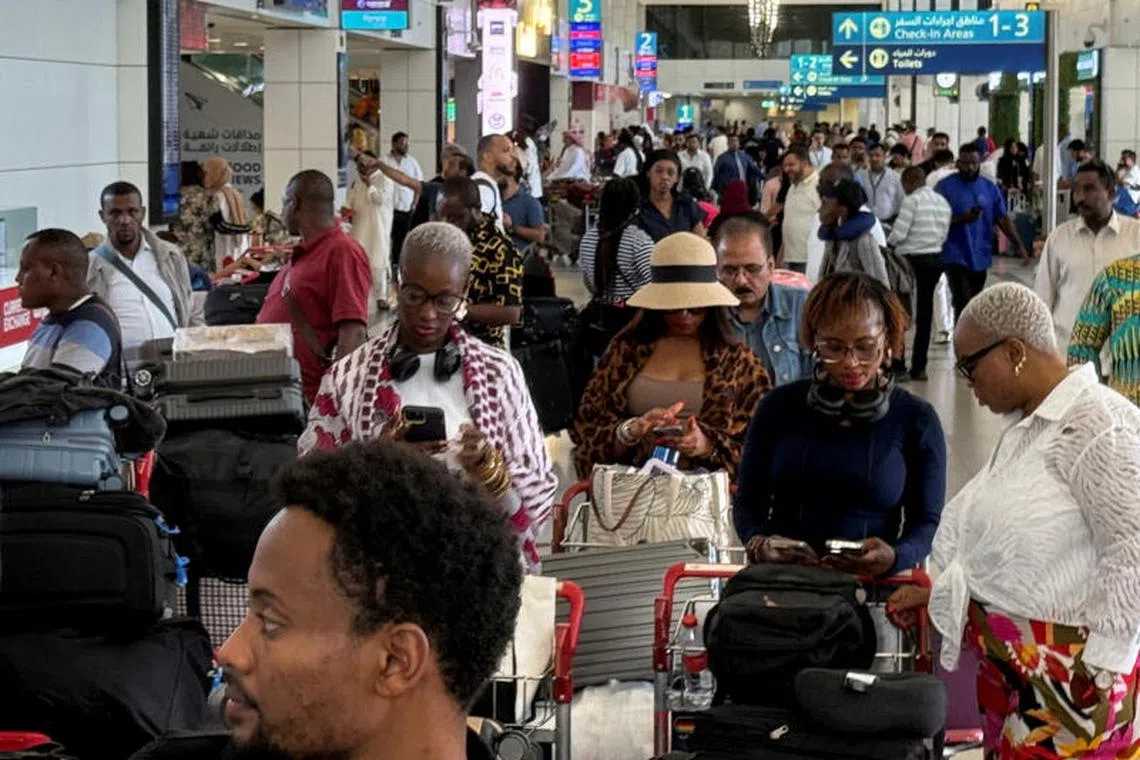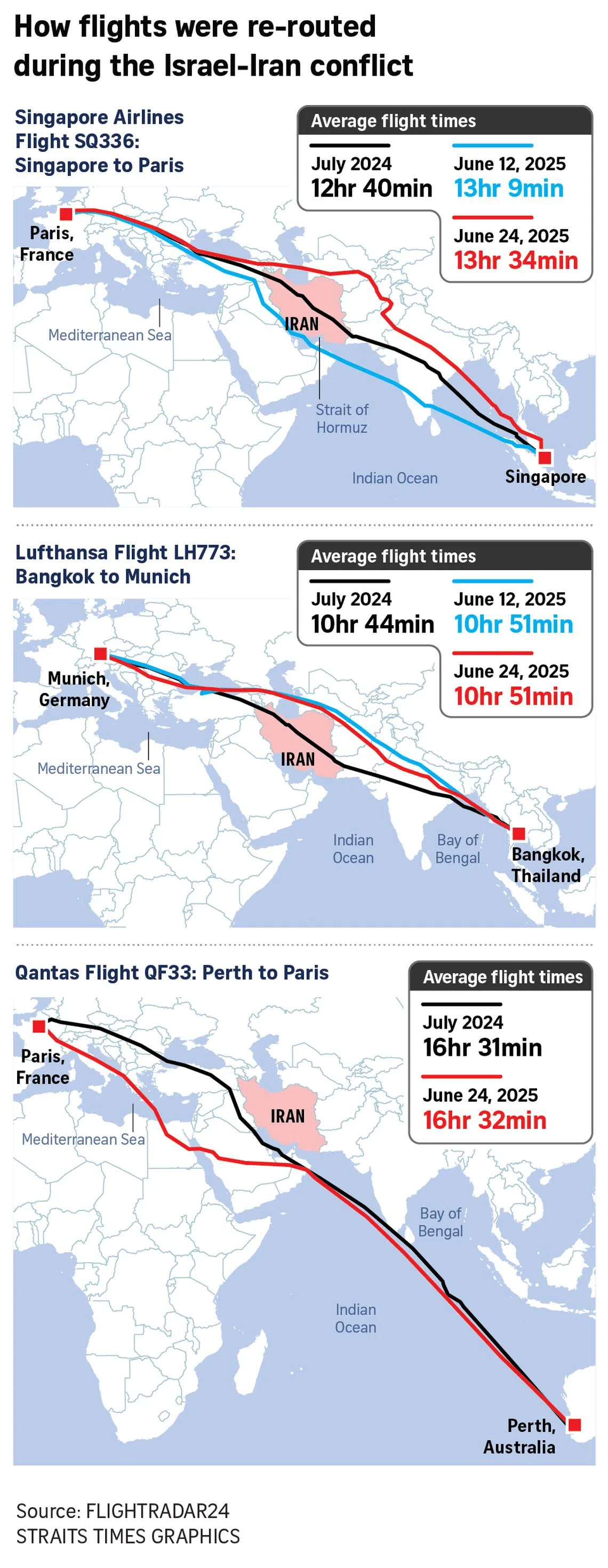Singapore travellers told to expect delays, even as Iran-Israel truce brings reprieve to airlines
Sign up now: Get ST's newsletters delivered to your inbox

Passengers queueing at Dubai International Airport in the United Arab Emirates on June 24.
PHOTO: REUTERS
Follow topic:
SINGAPORE – Singaporeans travelling to the Middle East and Europe over the coming days should be prepared for delays and disruptions, despite a fragile ceasefire between Iran and Israel offering a reprieve to airlines roiled by the fighting in the region.
With the truce appearing to take hold, national carrier Singapore Airlines (SIA) said on June 25 that it will resume flights to Dubai in the United Arab Emirates (UAE) on June 26, and its budget arm Scoot will restart flights to Jeddah in Saudi Arabia on June 28.
But even as airlines resume regular operations, those in the industry said the re-routing of aircraft to avoid the conflict zone will extend flight times, especially between Asia and Europe.
“Airlines are already running late for many of the re-routed flights,” said Associate Professor Lin Weiqiang, who studies transport issues at the National University of Singapore’s geography department.
“We can foresee more flight delays and perhaps schedule changes, if the usual corridors are not reopened soon,” he added.
SIA and Scoot had earlier cancelled flights to the Middle East after the US ordered air strikes on Iran’s three main nuclear sites on June 22.
SIA cancelled all of its Singapore-Dubai flights from June 22 to 25 after a security assessment. Meanwhile, Scoot cancelled its thrice-weekly Singapore-Jeddah services on June 23 and 26, citing operational considerations.
SIA Group on June 25 advised passengers to update their contact details via the Manage Booking function on the SIA and Scoot websites, or subscribe to SIA’s mobile notification service, to receive flight updates.
“The safety of our customers and staff is SIA Group’s top priority,” said a spokesperson.
Global flight operations were thrown into chaos late on June 23 when several Middle Eastern countries temporarily closed their airspace
The airspace closures, which were triggered by Iran’s missile strike on a US military base in Qatar, led to long delays and snaking queues at two of the world’s busiest airports, in Doha and Dubai.
Qatar Airways told The Straits Times on June 25 that it is making progress in restoring its flight schedules, with possible disruptions lasting until June 26.
The airline said customers with flights up to and including June 30 may reschedule to fly at a later date, up to July 15, without paying a fee, or they can get a refund if they no longer wish to travel.
With carriers likely to revisit their flight paths and schedules, travel-management firm FCM Travel Asia said it has informed business travellers to expect delays.
“We also recommend checking the travel advisory as posted by their local government, as the situation is fluid,” said the company’s managing director Bertrand Saillet.
Lufthansa Group said none of its flights to Singapore or the Asia-Pacific has been cancelled owing to the conflict.
But these flights may take up to an hour longer because of the need to skirt Lebanese, Jordanian, Iraqi, Israeli and Iranian airspace – a key artery for Asia-Europe air traffic before the Iran-Israel conflict erupted.
The airline group said it is also refraining from flying over the northern parts of Saudi Arabia, as well as Bahrain, Qatar and parts of the UAE in the Persian Gulf.
Flight-tracking data shows that Lufthansa’s flights between Singapore and Frankfurt, for instance, have been flying north of Iran, travelling through Pakistan, Afghanistan and Turkmenistan airspace instead.
This is the same “northern” flight path that some carriers like SIA take to fly to and from Europe.
Lufthansa has also been taking a “southern” route, flying over Oman, Saudi Arabia and Egypt.
Prof Lin said he expects airlines to continue re-routing flights via Pakistan, Afghanistan and Turkmenistan over the next few days and possibly weeks. This may add to the congestion there.
“As it is, Afghan airspace is already capacity controlled and has been subject to air traffic flow management since 2007,” he noted.
While some airlines like SIA had temporarily halted flights to the Middle East, Gulf carriers like Emirates, Etihad Airways and Qatar Airways have continued to fly to Singapore.
Asked why this was the case, Prof Lin said the airlines have different operational considerations, and it is likely that SIA Group was unwilling to risk its assets becoming collateral damage or getting stuck in the Middle East.
According to flight-tracking website Flightradar24, around 250 flights were cancelled at Hamad International Airport in Doha, with another 238 delayed, after Qatar, Bahrain and Kuwait temporarily shut their airspace on June 23.
Airports across Dubai in the UAE also briefly halted operations.
Dubai-based Emirates said there were some cancellations and a few flights had longer routes because of airspace congestion, but its passengers experienced minimal disruptions as regularly scheduled flights resumed within a few hours.
The carrier confirmed that none of its Singapore-Dubai flights were re-routed.
“The airline would never fly if it was not safe to do so. Emirates continuously monitors developments, coordinates with aviation authorities and assesses every potential risk,” it added on June 24.
A day earlier, the airline had said in an update that it will continue to operate flights as scheduled, using flight paths “well distanced” from conflict areas.
Other carriers like Air France have also begun to resume flights to the Middle East.
The French carrier told ST that it plans to resume services from Paris to Dubai and Riyadh starting on June 25, and restart flights between Paris and Beirut in Lebanon from June 26.
The airline said it is closely monitoring the situation in the Near and Middle East in real time. “Air France reiterates that the safety of its customers and crew is its absolute imperative,” it added.
For Australian flag carrier Qantas, which had two flights from Perth to Europe diverted as a result of the airspace closures in the Middle East, normal operations have also resumed.
Its Europe-bound flights on June 24 departed from Singapore and Perth without a hitch.
Qantas has been re-routing its European flights to avoid conflict zones in the Middle East for weeks now. The airline said on June 24 that it continues to monitor airspace availability closely, and it will alter its schedule as required.

Prof Lin said he believes it is safe for travellers to fly to where airlines are allowed to operate. What is more likely in the next few days are sudden disruptions and airspace closures, given the volatility of the situation.
“Travellers should strive to leave enough time for connections in case of any delays or misallocation of equipment,” he said.
Those who wish to further minimise risks when flying to Europe could also opt for airlines that maintain a wider berth from the conflict area, he added, pointing to Cathay Pacific, which flies to Europe via Xinjiang and Central Asia, as an example.
Kok Yufeng is a transport correspondent at The Straits Times.


